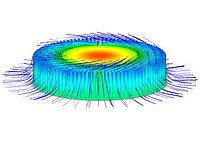
Photo from wikipedia
Abstract In this paper, we explored the feasibility of a novel 3D vapor chamber (3DVC) to fulfill the requirement of energy utilization for electric vehicle (EV) battery thermal management system… Click to show full abstract
Abstract In this paper, we explored the feasibility of a novel 3D vapor chamber (3DVC) to fulfill the requirement of energy utilization for electric vehicle (EV) battery thermal management system (BTMS). Compared with the flat shape of conventional vapor chambers (VC), the prepared 3DVC consists of three interconnected but non-coplanar chambers. A series of trials are implemented as the following subsequence. Initially, the performances of 3DVCs with 60% and 120% filling ratios are compared to understand the effect of filling ratio. The experimental results imply that the 3DVC with higher filling ratio (120%) performs better, especially at high heating powers, due to the sufficient liquid supplement. To validate the adaptability of 3DVC working under different road conditions and different installation locations, the impacts of orientation are investigated. The results confirm that the inclinations have slender influence on the performance of 3DVC owing to the capillary porous structures. Meanwhile, 3DVC based BTMS is tested both in high and low ambient temperatures to further characterize the thermal behaviors under various climates. It shows that 3DVC can maintain an appropriate temperature under the simulated weathers. The as-constructed 3DVC is expected to provide a promising strategy for energy management of EVs.
Journal Title: Applied Thermal Engineering
Year Published: 2019
Link to full text (if available)
Share on Social Media: Sign Up to like & get
recommendations!